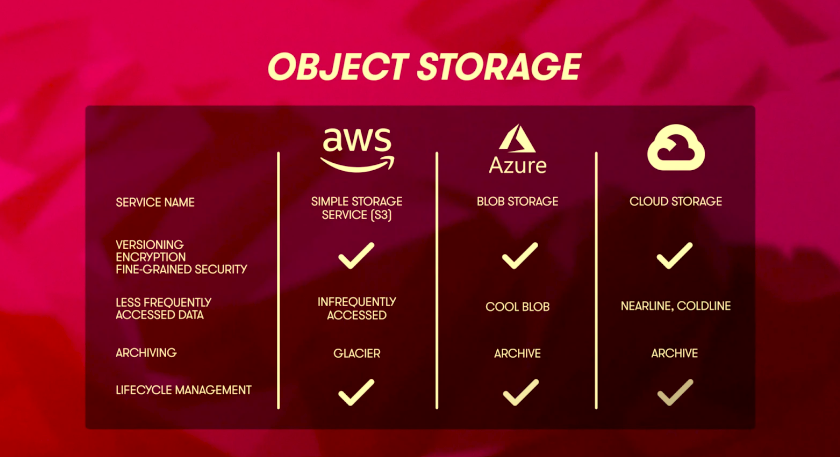Table of Contents
Introduction
In the technology of cloud storage, there are three famous cloud provider Google Cloud Storage, Amazon Web Services S3, and Azure Blob. They offer various offers to the users such as reliability and scalability in this term we have to know about what offers they offer and what is the best cloud storage provider. In this blog, we will learn how Google Cloud Storage differs from Amazon S3 and Azure Blob.
Know about Google Cloud Storage, Amazon S3, and Azure Blob
Google Cloud Storage offers different types of storage for different types of situations and usage such as Standard storage, Nearline storage, Coldline storage, and archive storage. Amazon Web Services (AWS) provides various types of storage services to cater to different use cases and requirements. Amazon S3 (simple storage service), Amazon EBS (Elastic Block Store), Amazon EFS (Elastic File System), Amazon FSx, and Amazon Glacier are services that AWS provides. Similarly Microsoft Azure also provides a variety of services. Here are some examples of Microsoft Azure’s key services Blob storage, Hot Cool and Archive Tier, Data Protection and Security, Integration with Azure Services, Blob Versioning and Lifecycle Management, and Hybrid Storage Solution.

Let’s understand how Google Storage differs from AWS S3 and Azure.
Three popular cloud storage solutions, AWS S3, Azure Blob, and Google Cloud Storage, offer reliable and scalable options for businesses. Each of these solutions has its own unique benefits. When choosing a cloud storage provider, businesses should carefully assess their storage needs and consider factors like performance, security, integration capabilities, and cost-efficiency. By doing so, they can make an informed decision that aligns with their specific requirements and enables effortless storage and retrieval of data in the cloud. Here are some differences between these three storages written below.
Pricing Module
- Google Storage: Google Cloud Storage offers a pay-as-you-go pricing model based on factors such as storage usage, data egress (outbound data transfer), and additional features like data retrieval and operations. They provide various storage classes with different pricing tiers.
- AWS S3: Amazon S3 also follows a pay-as-you-go pricing model based on data storage, data transfer, and optional features such as data retrieval and request types. It offers multiple storage classes with different pricing structures.
- Azure Blob Storage: Azure Blob Storage utilizes a similar pay-as-you-go pricing model, charging for storage consumption, data transfer, and optional features like data retrieval and operations. Azure provides various storage tiers with different pricing options.
Storage Classes
- Google Storage: Google Cloud Storage offers different storage classes, including Standard, Nearline, Coldline, and Archive. Each class has varying performance, availability, and pricing characteristics, allowing users to choose the most suitable option based on their data access requirements.
- AWS S3: Amazon S3 provides storage classes such as Standard, Intelligent-Tiering, Standard-IA (Infrequent Access), One Zone-IA, Glacier, and Glacier Deep Archive. These classes offer different availability, durability, and retrieval options to optimize cost and performance.
- Azure Blob Storage: Azure Blob Storage provides storage tiers like Hot, Cool, and Archive. Each tier has distinct characteristics in terms of availability, access frequency, and pricing, enabling users to align their data with the appropriate tier.
Data Transfer and Egress
- Google Storage: Google Cloud Storage charges for data egress, which refers to outbound data transfer from the storage service. Pricing varies depending on the destination and volume of data transferred.
- AWS S3: Amazon S3 also imposes charges for data transfer and data egress. Transfer costs depend on factors such as data volume, the source of transfer, and the destination region.
- Azure Blob Storage: Azure Blob Storage involves data transfer costs for both ingresses (data incoming to storage) and egress (data outgoing from storage). Pricing differs based on the region and the amount of data transferred.
Integration and Ecosystem
- Google Storage: Google Cloud Storage integrates well with other Google Cloud Platform services, making it convenient for users who already utilize Google Cloud services. It offers APIs and SDKs for various programming languages.
- AWS S3: Amazon S3 is a prominent part of the comprehensive AWS ecosystem, allowing seamless integration with other AWS services. It provides extensive SDKs, APIs, and tools for easy integration and development.
- Azure Blob Storage: Azure Blob Storage is tightly integrated into the Microsoft Azure ecosystem. It works well with other Azure services, and Microsoft provides SDKs, APIs, and tooling for developers to integrate with the storage service.
Conclusion
Google Cloud Storage. AWS S3 and Azure Blob are powerful storage solutions with great service for every type of usage and situation. Google Cloud storage emphasizes flexibility, global scalability, and integration within the Google Cloud Platform. AWS S3 offers exceptional durability and extensive integrations within the AWS ecosystem. Azure Blob stands out with its robust security features, hybrid capabilities, and seamless integration with other Azure services. Understand all three platforms we can say they provide great storage solutions.

Leave a Reply